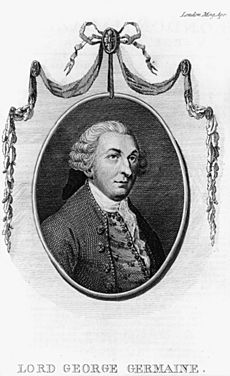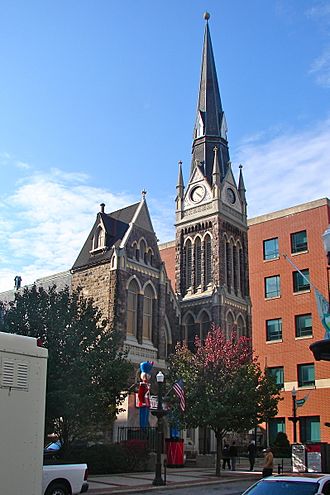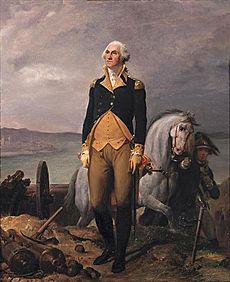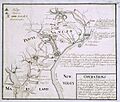Philadelphia campaign facts for kids
Quick facts for kids Philadelphia campaign |
|||||||
|---|---|---|---|---|---|---|---|
| Part of the Pennsylvanian front of the American Revolutionary War | |||||||
 Statue of Anthony Wayne at Valley Forge |
|||||||
|
|||||||
| Belligerents | |||||||
Oneida |
|||||||
| Commanders and leaders | |||||||
|
|
|
||||||
| Strength | |||||||
| Around 20,000+ | Around 16,000+ | ||||||
The Philadelphia Campaign (1777–1778) was a big effort by the British army during the American Revolutionary War. Their main goal was to capture Philadelphia. At that time, Philadelphia was like the capital city for the American rebels, where the Second Continental Congress met.
British General William Howe first tried to fight General George Washington's Continental Army in northern New Jersey. When that didn't work, he put his soldiers on ships. They sailed to the top of Chesapeake Bay. From there, he marched his army north toward Philadelphia.
Washington tried to stop Howe's army at Brandywine Creek. But on September 11, 1777, the British used a clever move called a "flanking maneuver." This meant they went around the side of Washington's army. The Americans were defeated in the Battle of Brandywine.
After more small fights, Howe's army marched into Philadelphia and took control. Washington then tried to attack a British group in Germantown. This attack was not successful. After this, Washington and his army went to Valley Forge for the winter.
Howe's plan was a bit controversial. Even though he captured Philadelphia, he moved very slowly. He also did not help another British general, John Burgoyne, who was fighting further north. Burgoyne's campaign ended badly for the British at Saratoga. This defeat was a big moment because it convinced France to join the war and help the Americans.
General Howe resigned while in Philadelphia. His second-in-command, General Sir Henry Clinton, took over. In 1778, Clinton moved the British troops from Philadelphia back to New York City. He wanted to make New York's defenses stronger in case France and America attacked. Washington's army chased the British across New Jersey. They fought a large battle at Monmouth Court House. This was one of the biggest battles of the war.
By the end of the campaign, both armies were back in almost the same places they started.
Contents
Why the Campaign Happened
After General William Howe captured New York City, General George Washington won important battles at Trenton and Princeton. This led to a quiet period in early 1777. During this time, the British army stayed in their outposts in New Brunswick and Perth Amboy, New Jersey. There were many small fights, but no major battles.

General Howe suggested a plan to George Germain. Germain was the British official in charge of the war. Howe wanted to capture Philadelphia in 1777. Philadelphia was the home of the Second Continental Congress, which was the American rebel government. Germain approved Howe's plan, but gave him fewer soldiers than he asked for.
Germain also approved a plan for General John Burgoyne. Burgoyne was to march his army from Montreal to Albany. Germain expected Howe to help Burgoyne by sending troops north from New York City. However, Howe decided not to march his army overland to Philadelphia. This would have meant crossing the wide Delaware River while facing enemy attacks.
Howe chose to take his army by sea to Philadelphia. This meant Burgoyne would not get much help from Howe. The British soldiers left in New York City would be too few to help Burgoyne.
Howe's Changing Plans

Washington wondered why Howe didn't work with General Burgoyne. Historians also agree that Lord Germain did not do a good job of planning the two campaigns together. After Howe captured New York, he wrote to Germain in December 1776. He suggested several campaigns for 1777. These included taking control of the Hudson River and capturing Philadelphia. Howe believed attacking Philadelphia would be good because Washington's main army was near the city.
Germain liked Howe's plan for Philadelphia. But he said he could not provide enough soldiers. After some defeats in New Jersey, Howe suggested attacking Philadelphia by land and sea. He hoped this would lead to a big victory. Washington thought Howe was building bridges to cross the Delaware River. But by May, Howe decided to go by sea. He wrote, "I propose to invade Pennsylvania by sea... we must probably abandon the Jersies."
Some historians think Howe didn't help Burgoyne because he wanted all the credit for a successful campaign. He might have been jealous of Burgoyne. Howe himself wrote to Burgoyne on July 17, "My intention is for Pennsylvania, where I expect to meet Washington." He sailed from New York soon after.
Early Moves and Feints

Washington's Continental Army spent the winter mainly at Morristown, New Jersey. There was also a small base at Bound Brook, close to British outposts. In April 1777, General Charles Cornwallis led a raid on Bound Brook. He almost captured the American commander, Benjamin Lincoln.
After this raid, Washington moved his army to a strong position at Middlebrook. This spot in the Watchung Mountains controlled the likely British land routes to Philadelphia. General Howe then moved a large part of his army to Somerset Court House. It's not clear why he did this. If he was trying to trick Washington into leaving his strong position, it didn't work. Washington knew Howe didn't have the right equipment to cross the Delaware River.
Howe eventually moved his army back toward Perth Amboy. Washington followed them. Howe then tried a quick attack, sending forces under Cornwallis to cut off Washington. This attack failed in the Battle of Short Hills. Howe then pulled his troops back to Perth Amboy. He put them on ships and sailed out of New York harbor, heading for Philadelphia.
Washington didn't know where Howe was going. He thought Howe might be tricking him and would sail up the Hudson River to join Burgoyne. So, Washington stayed near New York. He only moved his troops south to defend Philadelphia when he heard Howe's ships were at the mouth of the Delaware River. But the fleet didn't enter the Delaware. Instead, it kept sailing south. Washington thought Howe might be going to Charleston, South Carolina. Then he learned the fleet had entered Chesapeake Bay. In August, he began moving his troops south to prepare Philadelphia's defenses.
Taking Philadelphia
In late August, General Howe landed 15,000 British soldiers at the northern end of Chesapeake Bay. This was about 55 miles (90 km) southwest of Philadelphia. General Washington placed 11,000 American soldiers between Howe and Philadelphia. But the British outsmarted them at the Battle of Brandywine on September 11, 1777. Washington's army was pushed back and lost over 1,000 men. The British lost about half that number.
The Continental Congress (the American government) left Philadelphia. They moved first to Lancaster, Pennsylvania, and then to York, Pennsylvania. For several days, British and American forces moved around each other west of Philadelphia. They had small fights like the Battle of the Clouds and the "Paoli Massacre." On September 26, Howe finally outmaneuvered Washington. He marched into Philadelphia without a fight.
Capturing the American capital did not end the rebellion as the British hoped. In wars back then, capturing the enemy's capital usually meant winning. But the Revolutionary War continued for six more years until 1783. This was partly because the Americans used different fighting methods.
After taking Philadelphia, the British put about 9,000 soldiers in Germantown, which was 5 miles (8 km) north of the city. On October 2, the British captured Fort Billingsport in New Jersey. This helped them clear obstacles in the Delaware River. These obstacles were called chevaux de frise. They were designed by Benjamin Franklin and Robert Smith.
Washington unsuccessfully attacked Germantown on October 4. He then pulled back to watch the British. Meanwhile, the British needed to open a supply route along the Delaware River to get supplies to Philadelphia. The American and Pennsylvania Navies defended the river for a long time. But the British finally took Forts Mifflin and Mercer in mid-November. In early December, Washington successfully stopped several attacks by General Howe in the Battle of White Marsh.
Winter at Valley Forge
Washington and his army set up camp at Valley Forge in December 1777. This was about 20 miles (32 km) from Philadelphia. They stayed there for six months. During that winter, 2,500 out of 10,000 soldiers died from sickness and cold. However, the army became stronger thanks to a training program. This program was led by Baron von Steuben.
While the Americans were at Valley Forge, there was a change in the British command. General Howe resigned, and Lieutenant General Sir Henry Clinton became the new commander. France joining the war changed Britain's war plans. Clinton was ordered to leave Philadelphia and defend New York City. New York was now at risk from the French navy.
As the British prepared to leave, Washington sent Lafayette on a scouting mission. Lafayette barely escaped a British trap at the Battle of Barren Hill. The British also sent a peace group to America. This group offered peace in June 1778, but Congress rejected their offers.
Clinton sent many Loyalists (people loyal to Britain) and most of his heavy equipment by sea to New York. He left Philadelphia on June 18. Washington's army followed Clinton's army. Washington forced a battle at Monmouth Courthouse on June 28. This was the last major battle in the northern states. Washington's second-in-command, General Charles Lee, ordered a confusing retreat early in the battle. This allowed Clinton's army to regroup. By July, Clinton was in New York City, and Washington was back at White Plains, New York. Both armies were back where they had been two years earlier.
What Happened Next
Soon after the British arrived in New York, a French fleet appeared outside the harbor. This led to a lot of action from both sides. The French and Americans tried to attack the British at Newport, Rhode Island. This first attempt to work together did not go well.
Clinton was ordered by London to send some of his troops to the West Indies. He also started raiding coastal towns from the Chesapeake Bay to Massachusetts. Around New York, Clinton's and Washington's armies watched each other. They had small fights, with bigger actions like the 1779 Battle of Stony Point. Clinton thought about attacking Philadelphia again, but these plans never happened.
The British also started a wider frontier war. This was organized from Quebec City and involved Loyalists and Native American allies. British and French forces also fought in the West Indies and India starting in 1778. When Spain joined the war in 1779, it became even more global.
In 1780, the British started a "southern strategy." They aimed to regain control of the southern colonies. They captured Charleston, South Carolina. But this effort would eventually fail at Yorktown.
Images for kids
See also
 In Spanish: Campaña de Filadelfia para niños
In Spanish: Campaña de Filadelfia para niños










